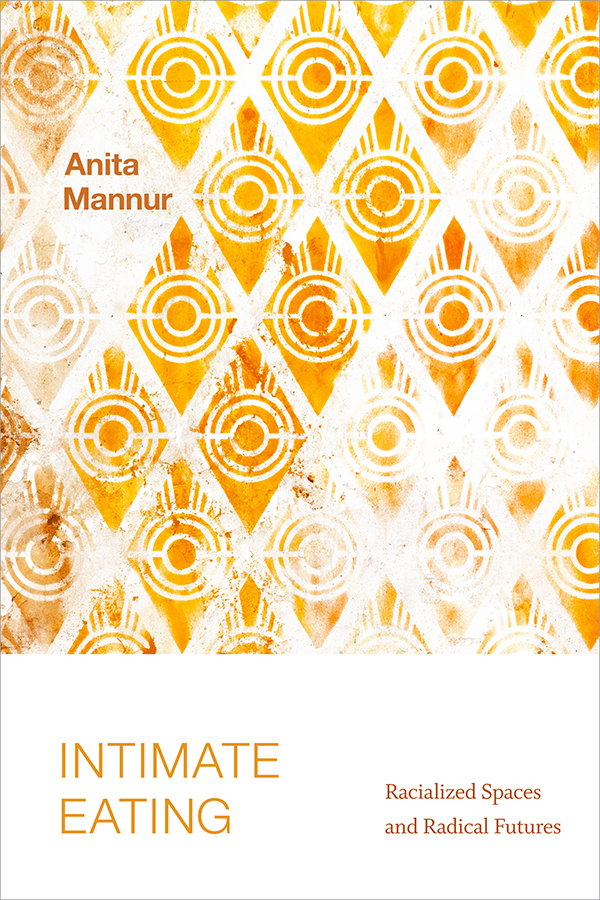The Book
Intimate Eating: Racialized Spaces and Radical Futures
The Author(s)
Anita Mannur

Anita Mannur, Professor of English and Asian/Asian American Studies at Miami University, has written a book of and for our times. This is not meant to pigeonhole this as a “pandemic book.” However, it is to recognize that the global pandemic provided a pause and a prompt for our reflections. Although one might not perceive this upon first reading, when I started re-reading, including the Acknowledgments, it struck me that this book may be considered a paean to the collective trauma of our 21st century lives, filled with isolation, anxiety, suffering, death, and racial scapegoating. The trauma goes on in secondary forms of social dysfunction and mental health crises large and small. In the midst of this, Mannur reflects upon and seeks the salve of intimacy. The ways in which she does so says as much about her – a self-described “foodie” and cultural critic – as it does about the circumstances. Simply put, Mannur finds salve in embracing radical “intimate eating publics” – that is, spaces of eating, whether alone or with others, that may be “vexed and contested,” but hold the promise of radical futures. Every element of these intimate eating publics disrupts the power structures underlying heteronormative assumptions about the culinary and commensality. In doing so, she offers a vision of reconfigured eating futures founded in fundamental queerness, new possibilities of kinship, and displaced sensate pleasures.
Mannur brings an acute tongue and sensory analysis to a wide range of contemporary samplings, which in itself provides a dizzying array of the author’s scope. These include the celebrated Indian film, Ritesh Batra’s The Lunchbox, Elizabeth Gilbert’s Eat, Pray, Love, Julie Powell’s Julie & Julia, Nani Power’s Ginger and Ganesh, Michael Rakowitz’s performance art installation Enemy Kitchen, and the popular British television show, The Great British Bake Off. Mannur also includes Sita Kuratomi Bhaumik’s provocative art installation “The Curry Institute” that invites/forces visitors to smell the fragrance/odor of curry as it wafts, unruly, throughout the museum from the art itself. (A portion of the work, “To Curry Favor,” provides the cover art of the volume.) Mannur intersperses textual analyses of these varied examples with scenes from her own life traumas, often painfully and vividly remembered through food. This tacking from the shared texts to personal experiences animates Mannur’s purposeful blurring of the public and the private. What ties these together is the assertion of food’s power to traverse time, space, and boundaries. Food is political and gains its assertions through multiple avenues and histories of sensate knowledge. And more provocatively, food can be subversive by its seductions of social justice that radicalize the plate of queer tarts into new norms of belonging.
This book is not an easy read, but suggests in its own crypticness the tomes that provide its intellectual and personal archaeology. This includes, but is not limited to, critical ethnic studies and queer theory, specifically Sara Ahmed, Lauren Berlant, Martin Manalansan IV, Gayatri Gopinath, and Michael Warner. Intimate Eating avails us of an “intimate reading public,” likewise “vexed and contested,” with shimmering radical promise. That radical promise suggests that our enclavic lives embedded within intersectionalities of race, class, gender, sexuality, space, and more may be broached more fully and deeply than otherwise by such provocations of intimacy.
About the Reviewer
Christine R. Yano, Professor of Anthropology at the University of Hawai`i, has conducted research on Japan and Japanese Americans with a focus on popular culture. In 2020-2021 she served as the President of the Association for Asian Studies. In 2022 she began her tenure as President-Elect of the Society for East Asian Anthropology, American Anthropological Association. Her publications include Tears of Longing: Nostalgia and the Nation in Japanese Popular Song (Harvard, 2002), Airborne Dreams: “Nisei” Stewardesses and Pan American World Airways (Duke, 2011), and Pink Globalization: Hello Kitty and its Trek Across the Pacific (Duke, 2013).

One Thought on this Post
S-USIH Comment Policy
We ask that those who participate in the discussions generated in the Comments section do so with the same decorum as they would in any other academic setting or context. Since the USIH bloggers write under our real names, we would prefer that our commenters also identify themselves by their real name. As our primary goal is to stimulate and engage in fruitful and productive discussion, ad hominem attacks (personal or professional), unnecessary insults, and/or mean-spiritedness have no place in the USIH Blog’s Comments section. Therefore, we reserve the right to remove any comments that contain any of the above and/or are not intended to further the discussion of the topic of the post. We welcome suggestions for corrections to any of our posts. As the official blog of the Society of US Intellectual History, we hope to foster a diverse community of scholars and readers who engage with one another in discussions of US intellectual history, broadly understood.
“This book is not an easy read, but suggests in its own crypticness the tomes that provide its intellectual and personal archaeology.”
That is for sure. So is this … https://blogdredd.blogspot.com/2023/10/on-origin-of-bass-akwards.html